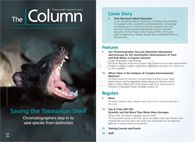Thermo and ASTM International Work Together to Assess Water Safety
Thermo Fisher Scientific (Sunnyvale, California, USA) and the American Society for Testing and Materials (ASTM) have developed an ion chromatography-based method for the simultaneous determination of nitrogen and phosphorous levels in water.
Thermo Fisher Scientific (Sunnyvale, California, USA) and ASTM International have developed an ion chromatography-based method for the simultaneous determination of nitrogen and phosphorous levels in water.
The “D8001 Test Method for Determination of Total Nitrogen, Total Kjeldahl Nitrogen by Calculation, and Total Phosphorus in Water and Waste Water by Ion Chromatography” allows users to concurrently monitor total nitrogen (organic nitrogen, ammonia, nitrate, and nitrite) as nitrate and total phosphorus as orthophosphate in unfiltered water samples.
Laboratories currently use two methods to determine total kjeldahl nitrogen (TKN) and total phosphate. The new method can be incorporated into existing ion chromatography protocols with the addition of a single sample digestion and analysis step to determine total nitrogen and total phosphate simultaneously. By comparing digested and undigested samples using this method, the TKN digestion method can be eliminated-saving time, disposal costs of acidic reagents, and reducing some of the known false positives from TKN that occur with the use of acidic reagents.
Robert Joyce, chairman of the ASTM International Subcommittee D19.06, said: “Thermo Fisher’s method provides a single, reliable instrumental method for the determination of the target analytes in water, in place of traditional multiple and complex wet chemical methods, with the opportunity for accumulative errors. We expect the method should deliver labour savings, as well as improved sensitivity and accuracy.”
Richard Jack, senior director, environmental and industrial marketing, chromatography and mass spectrometry, Thermo Fisher Scientific and ASTM member, commented: “Excess amounts of essential nutrients such as nitrogen and phosphorous can cause algal blooms, leading to the generation of toxic microcystins. With this new method, scientists should be able to identify excess nutrients in waterways from water treatment and agricultural runoffs.” This new method is available through the ASTM website: https://www.astm.org/Standards/D8001.htm.
For more information, please visit: www.thermofisher.com

Characterizing Plant Polysaccharides Using Size-Exclusion Chromatography
April 4th 2025With green chemistry becoming more standardized, Leena Pitkänen of Aalto University analyzed how useful size-exclusion chromatography (SEC) and asymmetric flow field-flow fractionation (AF4) could be in characterizing plant polysaccharides.
Investigating the Protective Effects of Frankincense Oil on Wound Healing with GC–MS
April 2nd 2025Frankincense essential oil is known for its anti-inflammatory, antioxidant, and therapeutic properties. A recent study investigated the protective effects of the oil in an excision wound model in rats, focusing on oxidative stress reduction, inflammatory cytokine modulation, and caspase-3 regulation; chemical composition of the oil was analyzed using gas chromatography–mass spectrometry (GC–MS).








